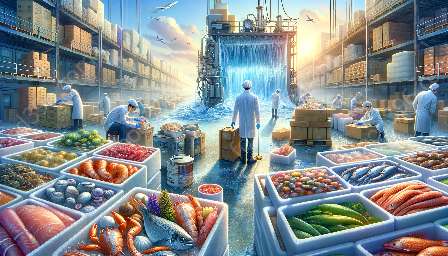Seafood is an essential part of many diets around the world, providing a rich source of nutrients. However, ensuring the quality and safety of seafood during storage is a critical concern. Chemical spoilage of seafood can occur during storage, impacting both the quality and safety of the product. This article explores the chemical spoilage of seafood, its implications for seafood science, and its relationship with seafood packaging and storage techniques.
Understanding Chemical Spoilage
Chemical spoilage of seafood refers to the deterioration of the product due to chemical reactions that affect its taste, texture, and overall quality. This type of spoilage is often caused by various factors, including oxidation, enzymatic reactions, and microbial activity.
Impacts on Seafood Science
Chemical spoilage significantly impacts the field of seafood science. Researchers and food scientists study the chemical processes that lead to spoilage to develop effective preservation methods and packaging techniques. Understanding the chemical changes that occur during seafood spoilage is crucial for maintaining the product's quality and safety.
Seafood Packaging and Storage
Proper packaging and storage play a crucial role in preventing chemical spoilage of seafood. Packaging materials and techniques are designed to protect seafood from external factors such as oxygen, light, and temperature fluctuations, which can accelerate chemical spoilage.
Factors Contributing to Chemical Spoilage
Several factors contribute to the chemical spoilage of seafood during storage. Some of the key factors include:
- Oxidation: Exposure to oxygen can lead to lipid oxidation, causing off-flavors and rancidity in seafood.
- Enzymatic Reactions: Enzymes present in seafood can catalyze chemical reactions, leading to changes in texture and flavor.
- Microbial Activity: The growth of spoilage-causing microorganisms can produce harmful byproducts, impacting the quality of seafood.
Preventing Chemical Spoilage
To prevent chemical spoilage of seafood during storage, it is essential to employ effective preservation and storage methods. Some key strategies include:
- Modified Atmosphere Packaging (MAP): MAP involves modifying the atmosphere within the packaging to reduce oxygen levels, slowing down oxidation processes.
- Cooling and Freezing: Maintaining low temperatures can slow down enzymatic and microbial activity, extending the shelf life of seafood.
- Antioxidants: Using natural or synthetic antioxidants can help prevent lipid oxidation in seafood products.
Conclusion
Chemical spoilage of seafood during storage is a complex phenomenon that involves various chemical reactions and processes. Understanding the impact of chemical spoilage on seafood science and implementing effective packaging and storage techniques is vital for maintaining the quality and safety of seafood products. By addressing the factors contributing to spoilage and employing preventive measures, the industry can ensure that consumers have access to high-quality and safe seafood products.

